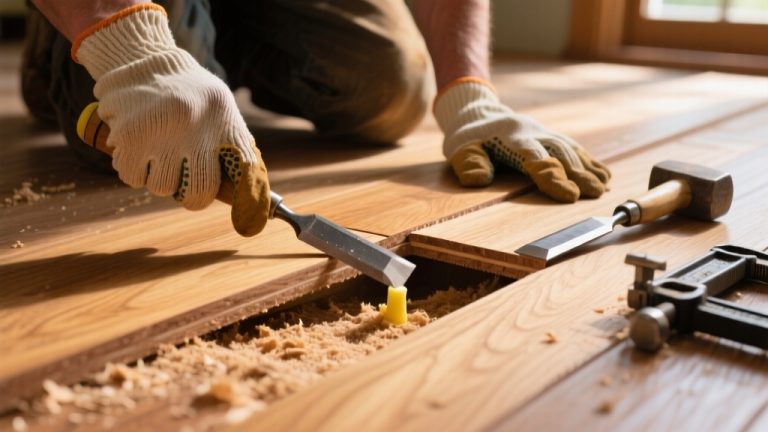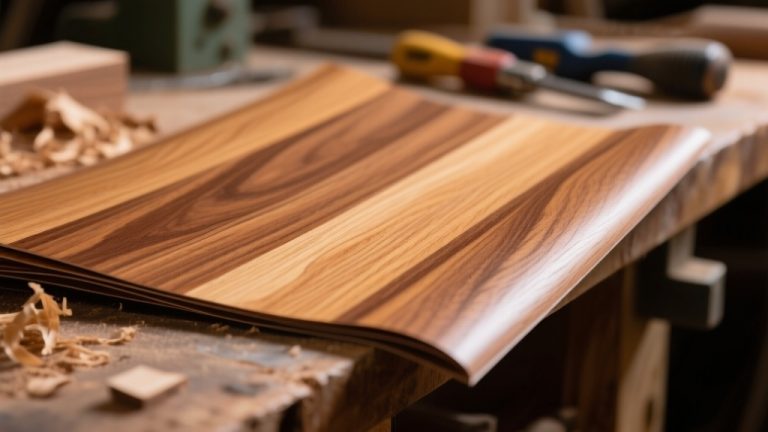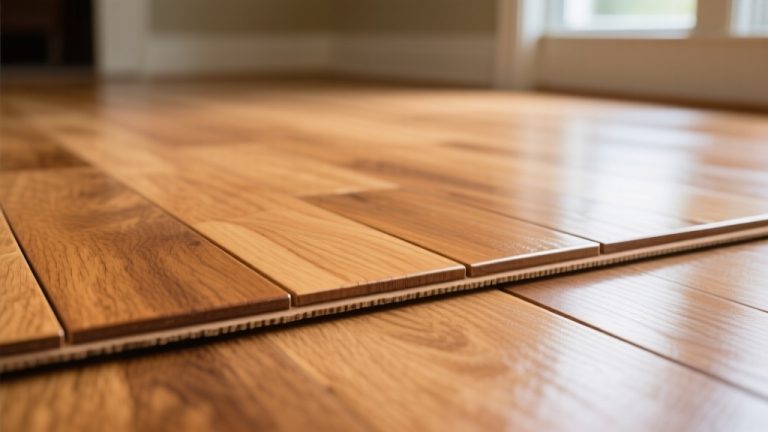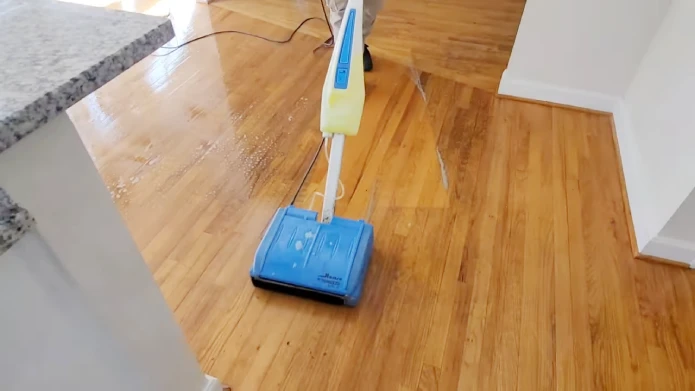How to Reduce Echo in a Room With Hardwood Floors?
To reduce echo on hardwood floors, start by adding thick area rugs with felt pads to absorb sound reflections. Furnish with plush upholstered pieces and arrange them to break sound paths.
Mount acoustic panels at key reflection points on walls and ceilings. Use soundproof underlayment beneath your flooring to cut impact noise. Incorporate plants and heavy curtains to further dampen reverberation.
Balancing absorption and diffusion tailored to your room’s size and shape will optimize clarity. Explore targeted tactics for all-encompassing acoustic control next.
Key Takeaways
- Add large, thick area rugs with padding to absorb sound reflections from hardwood floors and reduce echo.
- Incorporate plush upholstered furniture, cushions, and pillows to increase sound absorption in the room.
- Hang heavy curtains over windows and glass doors to minimize sound reflection and echo.
- Install acoustic panels strategically on walls and ceilings at reflection points, especially at ear level and corners.
- Use soundproof underlayment beneath hardwood floors and seal gaps to reduce impact noise and airborne sound leakage.
Understanding Echo in Rooms With Hardwood Flooring
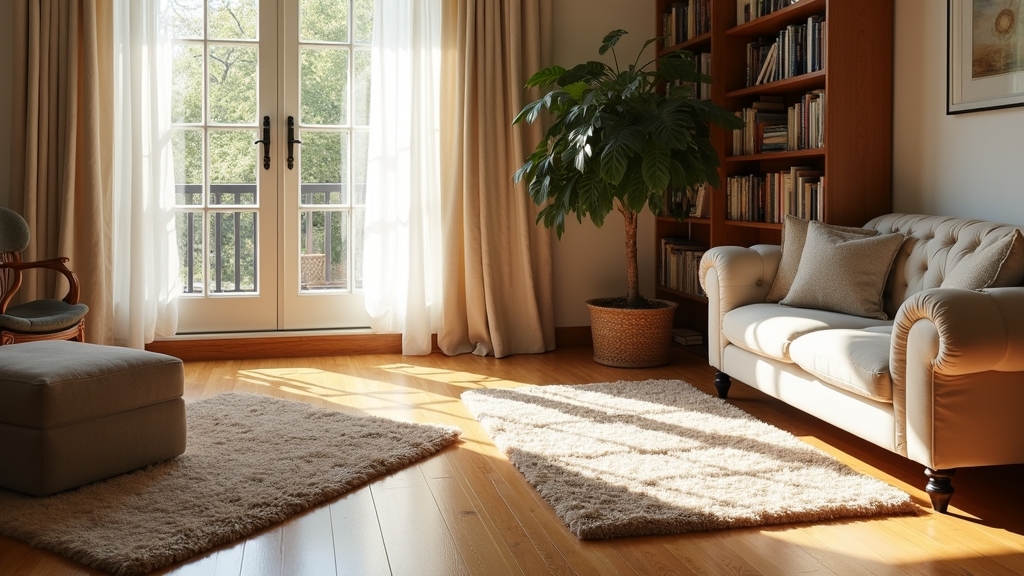
Because hardwood floors have smooth, dense surfaces, they reflect sound waves instead of absorbing them. This often leads to increased echo in your room. This reflective quality amplifies background noise and creates a “live” acoustic environment, especially in open layouts and rooms with high ceilings.
Without partitions or soft materials, sound waves bounce off multiple surfaces, including walls and ceilings, intensifying echo. Large windows and glass doors further contribute by reflecting sound. You’ll notice conversations becoming less clear and overall noise levels rising in these conditions.
Compared to carpet, hardwood floors provide minimal sound absorption, so echoes are more pronounced. The acoustic effects depend on room layout and flooring material, influencing how much echo you experience.
Choosing prefinished hardwood floors with durable finishes can help maintain the floor’s integrity and appearance despite acoustic challenges. Understanding these dynamics helps you identify why your room sounds echoey and guides you in managing sound reflections effectively.
Incorporating Soft Furnishings for Sound Absorption
When you add soft furnishings to a room with hardwood floors, you actively interrupt sound waves that would otherwise reflect off hard surfaces. This significantly reduces echo. Large area rugs paired with thick felt or memory foam pads absorb footstep noise and voices effectively.
Place these rugs in high-traffic zones or beneath furniture clusters for maximum impact. Using an appropriate underlayment beneath the hardwood can also enhance sound absorption by reducing impact noise.
Incorporate plush upholstered furniture like couches and armchairs strategically to break up open, reflective spaces. Adding cushions and pillows increases sound absorption by introducing more soft textures.
Distributing soft furnishings evenly along walls and in open areas prevents sound from bouncing directly back into the room’s center. Layering multiple rugs and textiles further diversifies absorption points, targeting a range of sound frequencies to optimize echo reduction in hardwood-floored rooms.
Installing thick curtains over windows also helps reduce sound reflections and minimize echo.
Utilizing Acoustic Wall Panels and Treatments
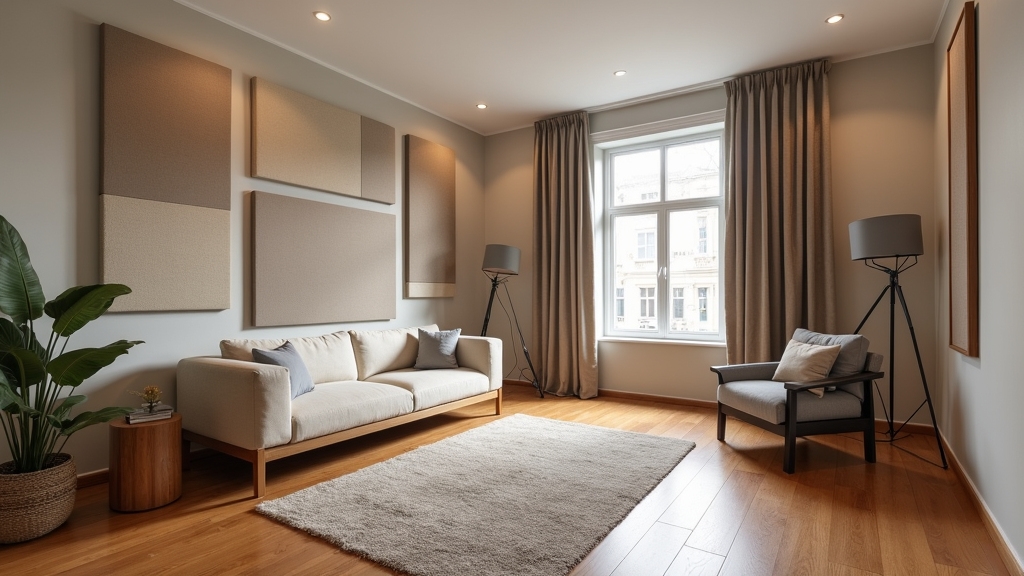
When it comes to choosing acoustic panels, it’s important to find ones that fit the specific frequency challenges of your room. You want to strike a balance between absorption and diffusion to effectively reduce echo.
And don’t forget about installation! Placing them strategically on walls or ceilings can make a big difference. This way, the panels can target those annoying sound reflections without making the space feel overly dampened.
Wood acoustic panels typically have a sound absorption coefficient greater than 0.9 in the 125-4000 Hz range, making them highly effective at reducing reverberation. Using wood also complements hardwood floors, preserving the room’s natural aesthetics and maintaining a healthy indoor environment.
Plus, there’s more than just the acoustic benefits. These panels can really up the style factor in your room, especially with those beautiful natural wood finishes. They also help with thermal insulation and are a great choice for anyone looking to be more environmentally conscious. So, it’s a win-win all around!
Types of Acoustic Panels
How do different types of acoustic panels affect sound control in rooms with hardwood floors? Each panel type targets specific sound frequencies and offers unique benefits. Proper moisture management is essential when installing acoustic treatments on hardwood floors to prevent damage such as warping or mold growth.
Fabric-wrapped and polyester felt panels excel at mid to high-frequency absorption. Wood panels provide combined absorption and diffusion. Foam panels handle high frequencies but may lack aesthetics.
For rooms with hardwood floors, adding an acoustic underlayment like WhisperMat-HW beneath the flooring can significantly enhance soundproofing by reducing impact noise and airborne sound transmission due to its soundproofing, moisture, and vapor emission protection features.
Thickness and material impact Noise Reduction Coefficient (NRC) and overall efficacy in reducing echo.
| Panel Type | Key Feature |
|---|---|
| Fabric-wrapped | High NRC, thermal benefits |
| Wood | Absorption + diffusion |
| Foam | High-frequency absorption |
Choosing the right panel depends on balancing absorption needs, aesthetics, and room use. This helps to optimize reverberation times and acoustic comfort effectively. Monitoring indoor humidity levels during and after installation can preserve hardwood floor integrity and maintain acoustic performance.
Installation and Placement
Although selecting the right acoustic panels is essential, their installation and placement determine their effectiveness in reducing echo.
Position panels between 4-6 feet high to target speech reflections from seated or standing occupants. Panels should be mounted at ear level to optimize sound absorption for the room’s primary use.
Space them symmetrically to guarantee even absorption. Avoid clustering panels; instead, distribute them evenly, prioritizing first reflection points identified via the mirror method.
Install ceiling panels directly above activity zones, spaced no more than four feet apart, especially in rooms with high ceilings. Don’t neglect corners; use bass traps in wall-ceiling junctions to absorb low frequencies.
Combine these treatments with floor coverings like rugs to minimize sound bounce from hardwood floors. This integrated approach ensures balanced absorption and markedly reduces echo, improving overall acoustic clarity.
Aesthetic and Functional Benefits
When you incorporate acoustic wall panels into a room with hardwood floors, you not only reduce echo but also enhance both aesthetic appeal and functionality.
These panels absorb sound waves, improving speech clarity and lowering noise pollution. Their customizable colors, textures, and materials allow seamless design integration, from minimalist to rustic styles.
Additionally, proper panel placement at first reflection points maximizes sound absorption and acoustic control. Using the right attachments and methods, such as a soft-bristled brush on hardwood can further improve acoustic quality by minimizing floor noise.
You can select thickness for targeted frequency absorption or shapes that fit architectural features. This versatility makes panels suitable for offices, classrooms, and living spaces alike.
| Benefit Type | Description | Practical Outcome |
|---|---|---|
| Aesthetic | Variety in colors, textures, and shapes | Seamless interior integration |
| Functional | Absorbs sound, reduces echo | Improved speech clarity |
| Environmental | Eco-friendly materials | Sustainable design |
| Customization | Custom cut panels | Fits unique architectural needs |
| Productivity Boost | Noise reduction | Enhanced concentration and comfort |
Selecting and Installing Flooring Underlayments
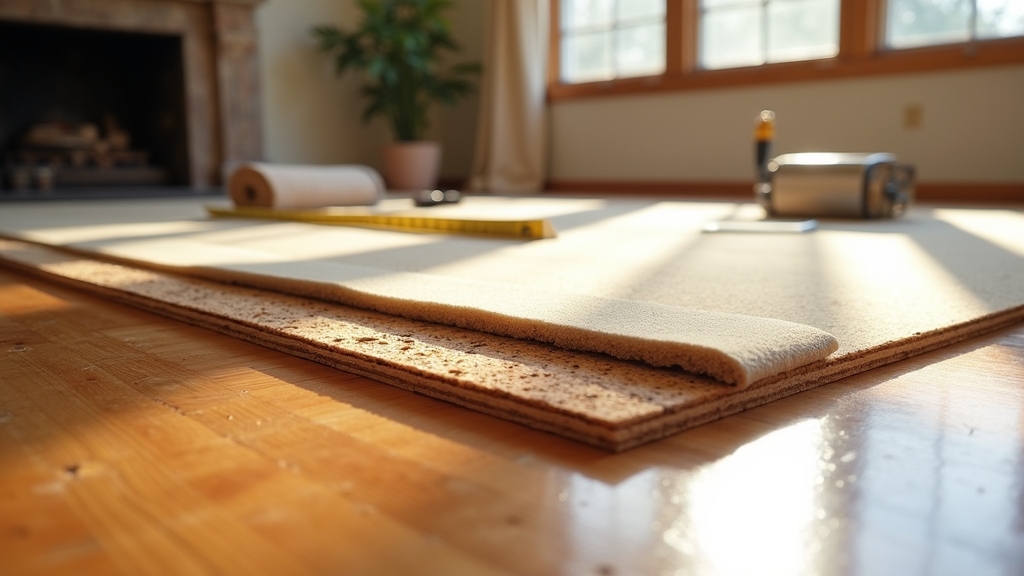
Since hardwood floors can amplify sound and reflect moisture, selecting the right underlayment is essential for reducing echo and protecting your flooring investment.
Choose cork underlayment for natural sound absorption and moderate moisture resistance, or opt for rubber-based types when superior sound dampening and moisture protection are priorities. Cork’s antimicrobial properties also make it resistant to mold, enhancing indoor air quality.
Additionally, underlayments with built-in moisture barriers can effectively prevent subfloor dampness that damages hardwood.
Synthetic felt underlayments balance sound reduction with moisture resistance, ideal for hardwood over concrete. Confirm your underlayment thickness matches your floor’s locking mechanism to maintain stability and acoustics.
Install the underlayment seamlessly without compression to preserve its soundproofing and moisture barrier properties. For added durability, consider vapor barrier options.
If you use radiant heat, select underlayments compatible with it. Proper selection and installation create an effective acoustic buffer and safeguard your hardwood floors against moisture damage.
Optimizing Furniture Placement to Minimize Echo
Beyond selecting the right underlayment, optimizing furniture placement plays a significant role in reducing echo in rooms with hardwood floors.
Optimizing furniture placement significantly reduces echo in hardwood-floored rooms beyond just choosing the right underlayment.
You want to strategically arrange furniture to disrupt sound reflection and absorb waves effectively. Positioning tall pieces like bookshelves perpendicular to walls breaks up flat surfaces, scattering sound.
Upholstered furniture placed near sound sources maximizes absorption, while varied shapes and textures enhance diffusion. Avoid clustering furniture centrally; instead, distribute pieces to section the room into smaller acoustic zones.
The lack of soft furnishings in rooms with hardwood floors often increases sound reflection, making furniture placement even more critical. Regular cleaning and maintenance of floors also help prevent dust buildup, which can affect both floor condition and indoor air quality.
Key strategies include:
Position furniture between sound sources and reflective surfaces to block direct reflections. Use upholstered sofas and chairs close to primary sound areas.
Arrange furniture in non-linear groupings to prevent sound channeling. Create defined zones with varied furniture to limit echo buildup and improve acoustic flow.
Enhancing Acoustics With Plants and Decorative Elements
Although hardwood floors can amplify sound reflections, incorporating plants and decorative elements can markedly enhance room acoustics by absorbing and diffusing sound waves.
Immediate action is required to prevent costly repairs or replacement when moisture causes damage, making it essential to control moisture levels in rooms with hardwood floors.
Use large, dense-leaved plants like rubber trees or fiddle leaf figs to maximize absorption. Layer decorative rugs with thick padding to dampen floor reflections. Heavy curtains and soft furnishings add additional sound absorption and diffusion.
Additionally, placing upholstered furniture strategically helps absorb sound and reduce echo throughout the room.
| Element Type | Acoustic Benefit | Practical Tips |
|---|---|---|
| Large Leafy Plants | Absorb and diffuse mid-high frequencies | Position near reflective surfaces |
| Area Rugs | Dampen floor reflections | Use thick padding; layer rugs |
| Heavy Curtains | Absorb sound from windows | Hang floor-to-ceiling with air gap |
| Upholstered Furniture | Absorb sound via porous materials | Add cushions for extra absorption |
| Bookshelves | Break up sound waves | Fill with books for mass and diffusion |
Combining Multiple Sound Reduction Strategies
When you combine multiple sound reduction methods, you considerably enhance a room’s acoustic performance by addressing noise from different angles.
Integrating various strategies targets both impact and airborne sound, minimizing echo effectively. To achieve ideal results, focus on these key tactics:
Combining methods addresses impact and airborne sound, effectively minimizing echo for optimal acoustic results.
Install soundproof underlayment (cork or rubber) beneath hardwood floors to disrupt vibration transmission and reduce impact noise. Selecting the appropriate underlayment is especially important for engineered hardwood floors, which have unique structural characteristics.
Place thick, dense area rugs in reflective zones and layer with padding to absorb sound waves. Adding large area rugs in high-traffic rooms not only minimizes echo but also protects the hardwood from scratches.
Position bulky, fabric-upholstered furniture against walls to block and absorb sound reflections. Seal floorboard gaps and edges with acoustic sealants and adhesives to prevent sound leakage between boards and at wall interfaces.
This multi-layered approach balances sound absorption and blocking, significantly reducing echo in hardwood-floored rooms.
Considering Room Size and Ceiling Height in Acoustic Planning
Combining sound reduction methods improves room acoustics, but understanding the room’s size and ceiling height shapes how those strategies perform.
The length-to-width ratio, ideally between 1.15 and 1.45, ensures even sound wave distribution and minimizes acoustic hot spots. Hardwood floors promote sound uniformity throughout a space, contributing to a balanced acoustic environment.
Higher ceilings increase room volume, extending reverberation time, which may require additional absorption or diffusion treatments on ceilings to control echoes, especially in hardwood-floored rooms.
Small rooms often amplify mode resonances, with hardwood floors intensifying reflections; here, area rugs and soft furnishings balance sound.
Larger rooms disperse sound over greater distances, demanding strategic placement of absorptive panels to reduce echo. Irregular shapes and architectural features influence sound behavior.
Frequently Asked Questions
Can Hardwood Floor Finishes Affect Echo Levels?
Yes, hardwood floor finishes do affect echo levels. Glossy or polyurethane finishes reflect sound more, increasing echo. Meanwhile, matte or satin finishes slightly diffuse sound, reducing echo marginally.
However, finishes mainly reflect rather than absorb sound, so their impact on echo is limited.
To effectively control echo, you need to combine finish choice with acoustic underlayments or other sound-absorbing treatments beneath the flooring for practical echo reduction.
How Does Door Type Influence Room Acoustics?
If you pick a hollow core door, you’re basically inviting sound to bounce and roar like it’s at a stadium concert.
Choosing a solid core or acoustic door slams the door on unwanted noise, sealing gaps and using dense materials to block sound transmission effectively.
Proper seals, quality hinges, and acoustic glazing in doors drastically reduce echo and noise pollution.
Are Ceiling Treatments Effective for Echo Reduction?
Yes, ceiling treatments are highly effective for echo reduction.
You’ll find that installing acoustic ceiling panels absorbs sound waves, preventing reflections from hard surfaces above. This markedly decreases reverberation, especially in rooms with high or vaulted ceilings.
Proper placement and sufficient coverage are key. You’ll want panels made from materials like bonded acoustical cotton for superior absorption.
Using these treatments, you can dramatically improve speech clarity and overall acoustic comfort.
What Role Do Windows Play in Sound Reflection?
Imagine sound waves bouncing off smooth glass like sunlight reflecting off a mirror.
Windows act as hard, reflective surfaces that send sound waves back into your room, intensifying echo and reverberation.
Since they don’t absorb sound, they amplify reflections alongside hardwood floors.
To control this, you need window treatments like thick curtains or cellular blinds that absorb sound and break up reflections.
This helps you reduce echo and improve clarity in your space.
Can Ambient Noise Machines Help Mask Echo?
Yes, ambient noise machines can effectively mask echo in rooms with hardwood floors. They emit consistent sounds like white or pink noise that blend reflected sound waves, reducing echo perception.
For best results, choose devices with high volume capacity, gapless playback, and customizable soundscapes.
While they don’t eliminate echo physically, these machines improve acoustic comfort by lowering echo salience. This aids focus, relaxation, and privacy in reflective environments.
Transform Noise into Comfort with Smart Adjustments
Reducing echo in your hardwood-floored room isn’t just about adding one fix. It’s about layering solutions like soft furnishings, acoustic panels, and strategic furniture placement. Think of it as tuning an instrument: each adjustment fine-tunes your space’s sound.
By combining these practical strategies and considering your room’s size and ceiling height, you’ll transform harsh echoes into balanced acoustics. Remember, the right blend turns noise into harmony, making your space both functional and comfortable.


